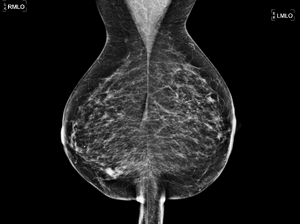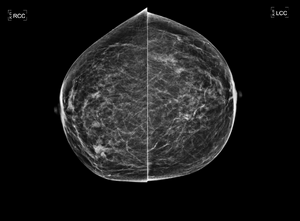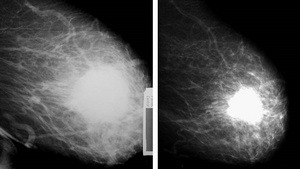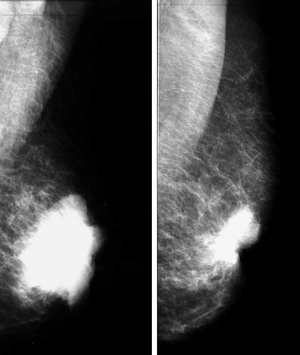Mammography
Mammography is a basic radiological screening and diagnostic method of breast examination. It is performed using a special X-ray device - a mammogram, which can image tissues with low contrast (soft tissues) through the so-called soft radiation. A mammogram differs from a regular X-ray in that it has an X-ray tube, special films, the use of compression and a special negatoscope for evaluation. Today, digital mammography techniques are used to advantage
Indication[edit | edit source]
Screening mammography[edit | edit source]
Screening mammography (film, digital, digitized) focuses on the preventive detection of early stages of breast cancer. In accordance with the decree of the Ministry of Health of the Czech Republic, it is performed on women who are free of problems and have no symptoms of breast cancer or a palpable lump = asymptomatic women. Screening is recommended for women aged 45 and over with a repeat every 2 years'[1]. The examination takes place at accredited workplaces, the evaluation is carried out by two doctors. The basis is the imaging of each breast in craniocaudal and oblique projection. If necessary, additional projections or targeted enlarged images are added. A general practitioner or gynecologist sends a woman for screening.
Diagnostic mammography[edit | edit source]
Diagnostic mammography (film, digital, digitized) is indicated for patients with suspected malignancy of the breast, present symptoms or for already diagnosed cancers = symptomatic women. In addition, regular checks are carried out on patients who have already experienced the disease or are being monitored in various specialist clinics.
Mammography in men[edit | edit source]
In men, mammography is indicated when there is a palpable resistance in the breast. We shoot on both sides in oblique projections.
Contraindications[edit | edit source]
Contraindications include pregnancy and breastfeeding.
Examination progress[edit | edit source]
During the examination, the breast is compressed with a compression plate. Breasts are imaged in two projections - craniocaudal and oblique mediolateral (45°).
Evaluation[edit | edit source]
Findings in mammographic screening are evaluated within the BI-RADS and according to Tabár. The goal of the screening is to search for tumors up to 2 cm in size without clinical symptoms.
Breast cancer appears in mammography as a star-shaped or oval shadow of varying size. However, it can also manifest itself as microcalcification. Mammography can be supplemented with other imaging methods (UZ, MRI, ductography), which are chosen according to the estimated yield of the examination.
Links[edit | edit source]
External links[edit | edit source]
- Institute of Biostatistics and Analysis. Mamo.cz : Mammography screening [online]. ©2015. [cit. 2015-07-23]. <http://www.mamo.cz>.
References[edit | edit source]
- ↑ Czech Republic. Decree of the Ministry of Health of the Czech Republic No. 3. In 2010. 2010. Available from <www.mamo.cz/res/file/legislativa/vyhlaska-3-2010.pdf>.












